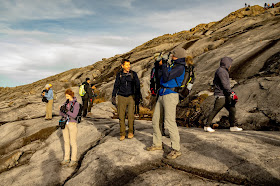Sunday, 21 October 2018
Sunday, 14 October 2018
Mount Kinabalu - Borneo
Mount Kinabalu’s specialty lies in its location at a renowned World Heritage Site, Kinabalu Park. Nature lovers will be delighted to be able to witness the many variations of flora and fauna that are to be found on the mountain at different altitudes.
Mount Kinabalu, along with other upland areas of the Crocker Range is well-known worldwide for its tremendous botanical and biological species biodiversity with plants of Himalayan, Australasian, and Indo-Malayan origin.
A recent botanical survey of the mountain estimated a staggering 5,000 to 6,000 plant species (excluding mosses and liverworts but including ferns), which is more than all of Europe and North America (excluding tropical regions of Mexico) combined. It is therefore one of the world’s most important biological sites.
Standing majestically at 4,095m (13,435 feet above sea level), Mount Kinabalu is the highest mountain between the Himalayas and New Guinea. Mount Kinabalu derives its name from the Kadazan word, ‘Aki Nabalu’, meaning ‘the revered place of the dead’. It is one of the safest and most conquerable peaks in the world—provided that you’re reasonably healthy and physically fit.
It took two days to climb up and down Mount Kinabalu. The Summit trail starts from the Timpohon Gate (1,800m) which is located near the Kinabalu Park Headquarters. Before reaching Panalaban (3,273m), we encountered a series of trail shelters (pondok) — Pondok Kandis (1,981m), Pondok Ubah (2,095m), Pondok Lowii (2,286m), Layang-Layang (2,702m), Pondok Villosa (2,690m), and Pondok Paka (3,080m). The climb from Timpohon Gate to Panalaban takes approximately 6 to 8 hours.
Upon arriving at Panalaban, we had some time to rest and recharge own energy. The climb to the summit resumed 2.45am the next morning. The climb to reach the summit requires climbers to climb endless steps and a scramble pulling yourself up a rope. The climb from Panalaban to the summit normally takes 4 to 5 hours before sunrise.
Kundasang War Memorial - Borneo
A must visit in Kundasang is the Kundasang War Memorial. Established in 1962, this was one of the first memorials to commemorate the brave Australian and British Prisoners of War who died in Sandakan and during the infamous death marches to Ranau during World War II. The memorial also remembers the people of North Borneo who risked their lives to help the POWs.
The Memorial is made up of four beautiful gardens - the Australian Garden, the English Garden, the Borneo Garden and the Contemplation Garden and Pool - to represent the different nationalities. With its towering pine trees and blooming roses, a walk in the gardens is reminiscent to that of a stroll in a quaint English garden. The scent of roses lingers in the air and the serene atmosphere makes the Kundasang War Memorial an ideal place to contemplate and remember the heroes of the war. Visitors can also opt to view a brief video on the history of the Sandakan Death March.


































































